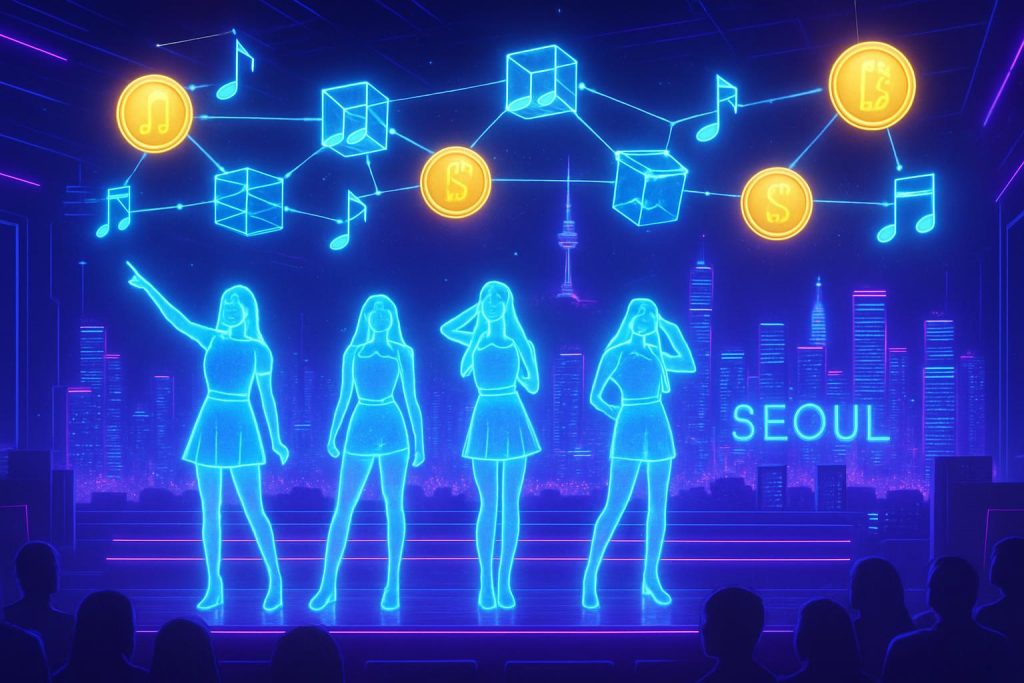The New Rhythm of Finance: A $100M K-Pop Deal Signals the Dawn of IP as a Liquid Asset

Introduction: The New Rhythm of Finance
On September 22, 2025, a transaction sent a powerful signal through finance, technology, and entertainment. Aria, an intellectual property (IP) tokenization platform, announced it was bringing a $100 million catalog of Korean music IP on-chain. This wasn’t another fleeting crypto headline; it was a meticulously engineered convergence of three global forces: the cultural juggernaut of Korean Pop (K-Pop), the maturation of blockchain into a serious infrastructure for Real-World Assets (RWAs), and institutional capital’s relentless search for new, uncorrelated yield.
This project, orchestrated by Aria on the foundational rails of Story Protocol, is a calculated, institutionally-backed move to build the financial infrastructure for the next generation of IP, as detailed in the initial announcement. It seeks to answer a multi-trillion-dollar question: can culture be systematically transformed into a liquid, tradable, and programmable asset class? The outcome will serve as a critical bellwether for the future of IP finance. This report dissects the anatomy of this landmark deal, analyzes its purpose-built technology and unique regulatory moat, and places it within the historical context of music monetization. It explores the powerful K-Pop economic engine that underpins the asset’s value and offers a forward-looking perspective on its prospects. What is unfolding is more than a novel investment product; it is a blueprint for the financialization of creativity itself.
Chapter 1: Anatomy of the Deal: More Than a Token Gesture
The September 22, 2025, announcement marked the launch of Aria PRIME, an institutional-grade platform for managing and investing in high-value IP. Its debut initiative was the tokenization of a Korean music copyright catalog valued at $100 million, or approximately 140 billion South Korean won. The sheer scale was notable, but its strategic depth was more significant. The catalog reportedly accounts for more than half of South Korea’s global music distribution market, immediately establishing the project as a major industry force. The deal is a complex orchestration involving specialized entities, each bridging the gap between a real-world cultural asset and a digital financial instrument.
The Key Players
At the heart of this venture are three core entities. Aria Protocol serves as the application layer—an investment bank for this new ecosystem. Founded by industry veterans like 20-year entertainment lawyer David Kostiner, Aria acquires IP rights, structures them into investable products, and offers them to the market. The firm recently secured $15 million in funding at a $50 million valuation, with backing from prominent VCs like Polychain Capital and the Story Protocol Foundation itself. Its business model is grounded in traditional finance, earning fees from token origination, secondary trading, and the management of curated IP vaults, as outlined in reports on the platform’s debut.
The foundational infrastructure is provided by Story Protocol, a purpose-built Layer-1 blockchain designed specifically for IP. It functions as the exchange, settlement system, and registry for this new asset class. Its specialized architecture is engineered to handle the unique complexities of IP—provenance tracking, licensing, and royalty distribution—that generic blockchains are not optimized for, a vision detailed on its foundation website.
The underlying assets are supplied by Contents Technologies, which provided the initial $100 million music catalog. This portfolio is not limited to a single genre; it includes rights associated with global superstars like BTS and BLACKPINK alongside notable trot singers, demonstrating the breadth of IP being brought on-chain, as highlighted in the Aria PRIME launch details.
The Mechanism: Aria PRIME and IPRWAs
The vehicle for this new market is Aria PRIME, a platform explicitly targeting permissioned, institutional-grade buyers. This focus distinguishes it from the retail-driven speculation of earlier crypto-music projects, signaling an intent to build a stable, compliant market.
The core innovation is the Intellectual Property Real-World Asset (IPRWA), a concept explored in a case study by the Story Foundation. Unlike past non-fungible tokens (NFTs), IPRWAs are fungible tokens. This means each token is interchangeable, much like shares of a company’s stock, allowing for deep liquidity and straightforward trading. As described in funding announcements for the project, each IPRWA represents fractional ownership of a real-world, revenue-generating asset—in this case, the royalty streams from the music catalog. This structure transforms a song from a cultural artifact into a yield-bearing instrument, enabling transparent ownership and seamless integration with the broader DeFi ecosystem.

The deliberate separation of the application layer (Aria) from the protocol layer (Story) is a sign of market maturation. This layered architecture mirrors successful economies where specialized firms build products on common infrastructure. This allows Story to focus on perfecting its role as the ultimate settlement layer for all forms of IP, while Aria concentrates on creating premier investment products. This model suggests a future where other “Arias” could emerge on Story’s rails, tokenizing film, art, or patents. This deal is not just a one-off transaction; it is the proof-of-concept for an entire, scalable IP economy.
| Entity | Function | Key Role in the Deal |
|---|---|---|
| Aria Protocol | Application Layer (IP Securitization & Investment Platform) | Structures and offers the tokenized IP via the institutional-grade Aria PRIME platform. |
| Story Protocol | Infrastructure Layer (L1 Blockchain for IP Settlement & Registration) | Provides the on-chain rails for token existence, smart contract execution, and IP lifecycle management. |
| Contents Technologies | Asset Originator (Music Catalog Provider) | Supplies the underlying $100 million portfolio of royalty-generating Korean music rights. |
| Seoul Exchange | Regulated Marketplace (Licensed Trading & Settlement Venue) | Provides the compliant, government-sanctioned venue for trading the tokenized assets. |
Chapter 2: The Infrastructure Layer: Why Story Protocol is the Main Act
While Aria provides the financial interface, Story Protocol is the fundamental innovation. Managing IP involves complexities that generic blockchains, designed for simple value transfer, are ill-equipped to handle. IP requires a system that can track provenance, manage licensing, automate royalty splits, and link on-chain data to off-chain legal rights. According to its technical documentation, Story Protocol was engineered from the ground up as a Layer-1 blockchain “purpose-built to make intellectual property programmable”.
Core Features of a Specialized IP Blockchain
Story Protocol’s architecture introduces several key features for IP management. Every piece of IP is registered as an IP Asset (IPA), an on-chain token serving as a unique identifier. Each IPA is linked to its own IP Account, a dedicated smart contract wallet that acts as a digital vault for the asset, holding all associated data, royalty policies, and license tokens.
The most crucial innovation is the Programmable IP License (PIL). This novel legal and technical framework bridges the gap between blockchain code and contract law. The PIL allows IP owners to embed legally enforceable terms directly into the on-chain asset, defining rules for commercial use, remixing, and revenue sharing in a transparent and automated way. This is enhanced by a modular design where customizable smart contracts for licensing, royalties, and dispute resolution can be attached to any IP Account, allowing for bespoke governance tailored to each creative work.
The Strategic Masterstroke: The Seoul Exchange Partnership
The technological sophistication of Story Protocol is impressive, but its most significant competitive advantage lies in its exclusive partnership with the Seoul Exchange. Announced in September 2025, this landmark agreement establishes Story Protocol as the sole infrastructure provider for the registration and settlement of all tokenized RWAs on the exchange for an initial three-year term.
The importance of this partnership cannot be overstated. The Seoul Exchange is one of only two platforms officially licensed by the South Korean government to operate within the country’s stringent financial regulatory sandbox for trading unlisted securities. This sandbox is the government’s designated pathway for fostering financial innovation under the direct supervision of the Financial Services Commission (FSC).
This partnership creates a powerful “regulatory moat” around Story Protocol’s operations. The greatest existential risk for any RWA project is regulatory uncertainty. By aligning with a government-sanctioned exchange, Story Protocol sidesteps this problem, transforming its platform from a tech venture into quasi-official financial market infrastructure. This move brings regulators into the process, providing a compliant environment for these new digital securities. This single partnership provides a green light for conservative institutional capital that would never engage with assets in a legal gray area, potentially unlocking billions in investment.
Chapter 3: A History of Harmony and Discord: From Bowie Bonds to NFT Busts
The concept of transforming music rights into an investable asset is not new, but the Aria and Story Protocol model represents a significant evolution. To appreciate its innovation, one must understand the history of its predecessors—both the successes and the failures.
The Precedent: Bowie Bonds and IP Securitization
The modern era of music finance began in 1997 with “Bowie Bonds.” In a revolutionary move, David Bowie bundled future royalty streams from his catalog into a $55 million asset-backed security. This was the first time an artist’s IP was used to back a publicly traded financial instrument, establishing the precedent that music royalties could be treated as a predictable, cash-flow-generating asset, as chronicled by legal and financial historians. However, this market was opaque, accessible only to institutional investors and requiring complex, bespoke legal structuring.
The Hype Cycle: The Rise and Fall of Music NFTs (2021-2022)
Two decades later, the 2021-2022 crypto boom promised to democratize this market through music NFTs. High-profile artists like Kings of Leon and DJ 3LAU launched projects, generating millions in sales and sparking a wave of hype, a trend that raised numerous copyright and legal questions. However, this first wave was built on a flawed foundation and ultimately collapsed.
The fundamental problems were manifold. The market was a speculative bubble, with prices driven by flipping rather than rational valuation. Most of these NFTs offered no real-world utility; they were essentially digital collectibles that provided no legal claim to royalties or ownership. The space was also rife with legal ambiguity and fraud, with artists seeing their work stolen and investors falling victim to “rug pulls,” leading to a widespread loss of confidence and a re-evaluation of the NFT market’s viability. This led to significant fan backlash, with many viewing the projects as cynical cash grabs. Even major K-Pop agency HYBE faced criticism from its own fanbase for its initial NFT plans, which were perceived as being out of touch with fan culture.
The Paradigm Shift: The IPRWA Model
The Aria and Story Protocol model is a direct response to these failures. It represents the maturation of the RWA thesis, applying lessons from the NFT bust to create a robust, utility-driven financial instrument. The IPRWA model is the antithesis of the 2021-era NFT. It is built on fungibility, a direct link to yield-bearing royalty streams, legally sound fractional ownership, and a foundation of regulatory compliance, as noted in early analyses of the protocol.
The failure of the first wave of music NFTs was a necessary market-clearing event. It taught the industry that for a digital asset to have sustainable value, the token must represent a legally sound, economically viable, and transparently managed claim on real-world cash flows. The NFT bust pruned the market of its speculative excesses, paving the way for a stronger model to grow in its place.
| Model | Traditional Securitization (Bowie Bonds) | NFT Collectibles (2021-era) | IPRWA Tokenization (Aria/Story Model) |
|---|---|---|---|
| Liquidity | Low | Fragmented | High |
| Investor Base | Institutional Only | Retail Speculators | Institutional & Retail Investors |
| Underlying Value | Royalty Streams | Speculative & Social | Royalty Streams |
| Programmability | None | Limited | High |
| Regulatory Path | Bespoke Legal | Unclear & Contested | Regulated Sandbox |
Chapter 4: The Trillion-Dollar Fandom: Sizing the K-Pop Financial Machine
The long-term success of any asset-backed security depends on the quality of the underlying asset. In this case, the asset is Korean music IP, an economic powerhouse driven by a unique business model and one of the most dedicated consumer bases in the world. While South Korea’s domestic music market is valued at a modest $800 million, its global impact is orders of magnitude larger. The global K-Pop events market alone was valued at over $13 billion in 2024 and is projected to reach nearly $24 billion by 2032. Between 2019 and 2023, the combined revenue of the four largest K-Pop agencies (HYBE, JYP, SM, YG) roughly tripled to nearly $3 billion, signaling a high-growth, cash-flow-rich industry.
A Unique Economic Model
Unlike the Western music industry, which is overwhelmingly reliant on streaming, K-Pop operates on a highly diversified economic model that creates more stable cash flows. Key revenue streams include:
- Physical Album Sales: K-Pop has engineered a boom in physical sales, selling albums as collectible packages with items like photo cards that drive fans to purchase multiple copies.
- Global Concert Tours: Groups like BTS and BLACKPINK sell out stadiums worldwide, generating massive revenue from tickets and merchandise, a core part of the global K-pop phenomenon.
- Merchandise and Licensing: From “light sticks” to brand endorsements, merchandise is a core component of the industry’s profitability.
- Digital Content and Streaming: While not the sole driver, global streaming on platforms like Spotify and YouTube still contributes significantly to royalty income, fueling a thriving IP economy.
This diversified model makes K-Pop IP a robust asset, less susceptible to fluctuations in any single revenue stream. Streamline your crypto payment acceptance with our customizable crypto payment button, designed for seamless integration across WordPress, Shopify, and YouTube platforms.
The Power of Fandom as an Economic Force
K-Pop fans are not passive consumers; they are active, organized economic participants. Data shows that K-Pop fans are significantly more likely to purchase physical media than the average music listener, often motivated by a desire to “show support” for their favorite artists. This deep engagement creates a powerful and predictable demand floor for IP-related products, making K-pop an intriguing alternative investment.
This cultural dynamic provides a significant advantage. The Western market has conditioned consumers to view music as an ephemeral service. In contrast, the K-Pop industry’s emphasis on collectibles has pre-conditioned its global fanbase to value owning a tangible piece of the music they love. The psychological leap from owning a collectible CD to owning a digital token representing a song’s royalties is therefore much smaller.
The industry’s global expansion is relentless. K-Pop album exports hit a record $132.9 million in the first half of 2023, and Korean is now the third-most-streamed language in the United States. This confirms the IP being tokenized has a global, growing, and highly monetizable audience. Despite this success, a strategic challenge persists for South Korea: the difficulty of capturing the full value of its “super IP,” with profits often flowing to foreign platforms. This context makes a domestic, on-chain solution for IP monetization not just a commercial opportunity, but a matter of national economic strategy.
Chapter 5: The Regulatory Sandbox: Navigating South Korea’s Digital Frontier
South Korea stands as one of the world’s most dynamic digital asset markets. It is characterized by exceptionally high retail adoption—with over 16 million users, representing roughly 32% of the population—and a government that is proactively building a comprehensive regulatory framework rather than resorting to reactive enforcement. This environment of high engagement and regulatory clarity creates fertile ground for well-structured projects.
A Comprehensive Legislative Framework
The South Korean government has moved decisively to bring order to the digital asset space. The cornerstone is the Virtual Asset User Protection Act (VAUPA), which took effect on July 19, 2024. This landmark legislation imposes strict obligations on Virtual Asset Service Providers (VASPs), including the segregation of customer assets, a requirement to hold at least 80% of user assets in secure “cold wallets,” and mandatory insurance coverage, as detailed in guides to South Korea’s crypto laws. It also grants the Financial Services Commission (FSC) broad supervisory powers to prevent market manipulation and insider trading, a key provision highlighted by the FSC itself.
Building on this is the forthcoming Digital Asset Basic Act (DABA), which will expand the legal definition of digital assets to formally include stablecoins and certain tokenized securities, establishing clear licensing regimes. The government is also developing a framework for Security Token Offerings (STOs) that will be regulated under the existing Financial Investment Services and Capital Markets Act (FSCMA), with the financial regulatory sandbox serving as the official testing ground for these new products, a move that has been closely watched by investors.
The Compliance Advantage
The strategic partnership between Story Protocol and the Seoul Exchange is designed to navigate this complex regulatory landscape perfectly. By launching on a licensed platform within the government’s official sandbox, the project positions its IPRWAs not as unregulated cryptocurrencies, but as compliant digital securities.
Paradoxically, South Korea’s strict regulatory environment serves as a powerful bullish catalyst for a project like Story/Aria. The high costs and complexity of complying with laws like VAUPA create formidable barriers to entry. Smaller or legally ambiguous competitors will be unable to meet these stringent standards. This will effectively clear the market of gray-area operators.

Projects like Story, which possess significant venture capital backing and a strategic alliance with a licensed financial entity, are positioned not only to survive but to thrive. The regulation, therefore, does not act as a headwind; it functions as a powerful tailwind, filtering out competition and signaling to the market that the remaining players are legitimate, trustworthy, and operating with the implicit sanction of the country’s top financial regulators.
Conclusion: The Expert’s Take — An Encore or a Swan Song?
The venture launched by Aria and Story Protocol is one of the most intelligently structured projects in the digital asset space. It has moved beyond naive techno-optimism and meticulously addressed the key failure points of its predecessors: technology, utility, and regulation. By synthesizing its components, a clear and compelling investment thesis emerges, though it is not without significant risks.
The Bull Case: A Perfect Storm
The argument for success rests on the convergence of four key factors. First, it is built upon a premier asset class: K-Pop IP is a high-growth, globally recognized asset generating predictable, diversified cash flows. Second, it leverages purpose-built technology: Story Protocol provides a superior infrastructure designed for the complexities of IP management. Third, and most critically, it possesses a clear regulatory moat: The exclusive partnership with the licensed Seoul Exchange provides a sanctioned, compliant path to market, dramatically de-risking the venture for institutional capital. Finally, it employs a mature model: The IPRWA approach prioritizes tangible financial utility over speculative hype.
The Bear Case: Navigating the Risks
Despite its strengths, the project faces non-trivial challenges. Execution risk remains paramount. The vision is immense, and the technical, legal, and operational hurdles are significant. The recent departure of Story Protocol co-founder Jason Zhao, while framed as a strategic pivot, introduces a degree of leadership instability that must be monitored, according to commentary on the controversial exit. Furthermore, as a crypto-adjacent asset, IPRWAs could still be subject to the broader market volatility of the digital asset market, potentially decoupling their price from the stable cash flows of the underlying IP. Finally, the challenge of IP valuation is persistent. Accurately pricing these traditionally illiquid assets will require sophisticated financial modeling.
Final Perspective
The Aria and Story Protocol project represents a paradigm shift in how cultural assets are financed. It has methodically assembled the necessary components for success: a world-class asset, specialized technology, and a compliant route to market. While execution risks are real, the strategic foresight demonstrated in its design sets it apart.
This is more than just an opportunity for fans to own a piece of a BTS song. It is the construction of the financial plumbing necessary to unlock the value of the estimated $80 trillion in illiquid intellectual property currently locked away in corporate vaults. If Aria and Story can execute their vision, this $100 million K-Pop deal will not just be a hit—it will be the chart-topping debut of an entirely new global asset class.

